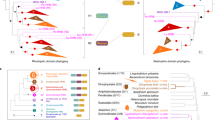Abstract.
Retinal proteins function as photoreceptors and ion pumps. Xanthorhodopsin of Salinibacter ruber is a recent addition to this diverse family. Its novel and distinctive feature is a second chromophore, a carotenoid, which serves as light-harvesting antenna. Here we discuss the properties of this carotenoid/retinal complex most relevant to its function (such as the specific binding site controlled by the retinal) and its relationship to other retinal proteins (bacteriorhodopsin, archaerhodopsin, proteorhodopsin and retinal photoreceptors of archaea and eukaryotes). Antenna addition to a retinal protein has not been observed among the archaea and emerged in bacteria apparently in response to environmental conditions where light-harvesting becomes a limiting factor in retinal protein functioning.
Similar content being viewed by others
Author information
Authors and Affiliations
Corresponding author
Additional information
Received 2 April 2007; received after revision 14 May 2007; accepted 16 May 2007
Rights and permissions
About this article
Cite this article
Balashov, S.P., Lanyi, J.K. Xanthorhodopsin: Proton pump with a carotenoid antenna. Cell. Mol. Life Sci. 64, 2323–2328 (2007). https://doi.org/10.1007/s00018-007-7167-y
Published:
Issue Date:
DOI: https://doi.org/10.1007/s00018-007-7167-y




